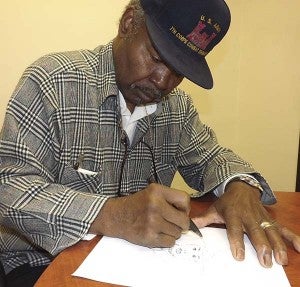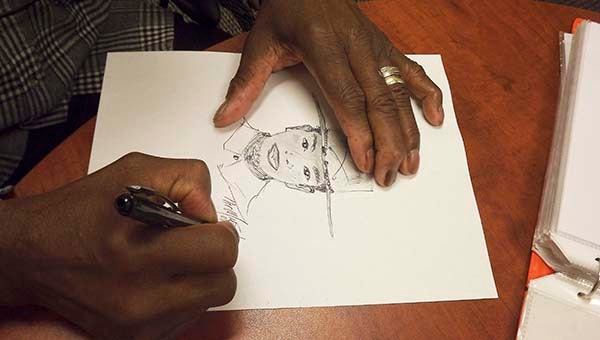Man imagines the faces of Buffalo Soldiers
Published 11:40 am Saturday, February 22, 2014

Thomas Murphy said he wants “to put a face to the unknown.” The picture he was drawing was the one on the bottom of the column. — STEPHEN H. COWLES | TIDEWATER NEWS
FRANKLIN—Thomas Murphy of Franklin has been putting his artistic skills to use lately in creating portraits of men he could never hope to meet.
Murphy, 68, has imagined the faces, uniforms and postures of men known as Buffalo Soldiers. That term describes the black American men who first served in the U.S. 10th Cavalry Regiment of the U.S. Army starting in the mid-1860s. Their numbers and ranks grew over the next several decades.
Legend has it that’s also the name given by Native Americans who confronted the cavalrymen.
One story that Murphy tells is of John Randall, who was a private in Troop G of the aforementioned cavalry. He was guiding civilians on a hunting trip when they were attacked by Cheyenne Indians. Though repeatedly wounded, Randall survived the ordeal. The Cheyenne reportedly described him as having strong qualities of the buffalo, as well as a similar color and texture of hair.
When Murphy learned of Randall, his imagination was evidently ignited.
“They [the Buffalo Soldiers] didn’t have the sophistication to be photographed,” said Murphy. Photography was in its infancy in the 19th century, and there wasn’t the ready access for each such cavalryman to be pictured.
He said he also got to thinking about the Tomb of the Unknown Soldier in Arlington. Murphy wondered who was that person and what did he look like? By extension, who were the other men who became Buffalo Soldiers, especially their faces?
“I’m putting a face to the unknown,” he said.
He doesn’t use models. Murphy said he relies on his imagination and the memory of men he has seen, even if just once. He added that after the drawing is completed, he might see a resemblance to people he knows. In a notebook thick with drawings, Murphy points out one that he realized looks like a neighbor he called Travis. The picture is the second from the bottom. The man with the spectacles was Murphy’s first portrait, by the way.
The artist knows something of military life himself. A native of Franklin, he was drafted into the Army. After basic training at Ft. Bragg, N.C., and advanced training at Ft. Lee, Va., Murphy served from 1966 to 1968. He was with the 7th U.S. Army Corps Combat Engineers. Included in the service was a tour of duty in Germany.
“I wish every young man would go into the military,” said Murphy. “It gives him stability and things he could not learn at home, like how to carry yourself as a gentleman.
“I’m proud to have been in service.”
The artistic talent showed up when he was 6 years old, and Murphy describes that time as being “lonesome in school.”
“School didn’t interest me at that early age. I found myself scribbling and drawing,” he recalled. “In my second or third year at school, I designed bulletin boards, like for Christmas.”
By sixth or seventh grade is when he began to take an interest in school and seriously apply himself. He absorbed what people repeatedly told him: without an education, life would be much more difficult.
Before being drafted at age 20, Murphy said, he worked at the Haynes Basket Co., which was located on Roosevelt Street. After returning from service, he worked in the pallet shop and later as a pipe fitter’s helper at Union Camp.
Returning to the topic of drawing, Murphy doesn’t always have a definite idea of what he’ll create. Or, if he does, the final product might be something more.
“Lots of time you’re drawing and you don’t know where it will take you,” he said. “A peace comes to me when I draw. Sometimes it gets you there, sometimes it doesn’t.”
The portraits of the Buffalo soldiers can take him about 15 minutes.
At this reporter’s request, Murphy takes the pen in hand and starts his drawing, which is completed about 10 or so minutes later. The result can be seen in the picture at the bottom left.
Capitalizing on the talent is not his motivation.
There have been showings of his artwork, such as the time he got Best in Show at the county fair. Yes, money has been made from Murphy selling his pictures, but he also figures to have spent more than $45,000 throughout the years. He said he’s made more money playing drums at Piney Grove Baptist Church than from his art.
The ability to draw he credits elsewhere.
“It’s just something God gave me,” said Murphy.











